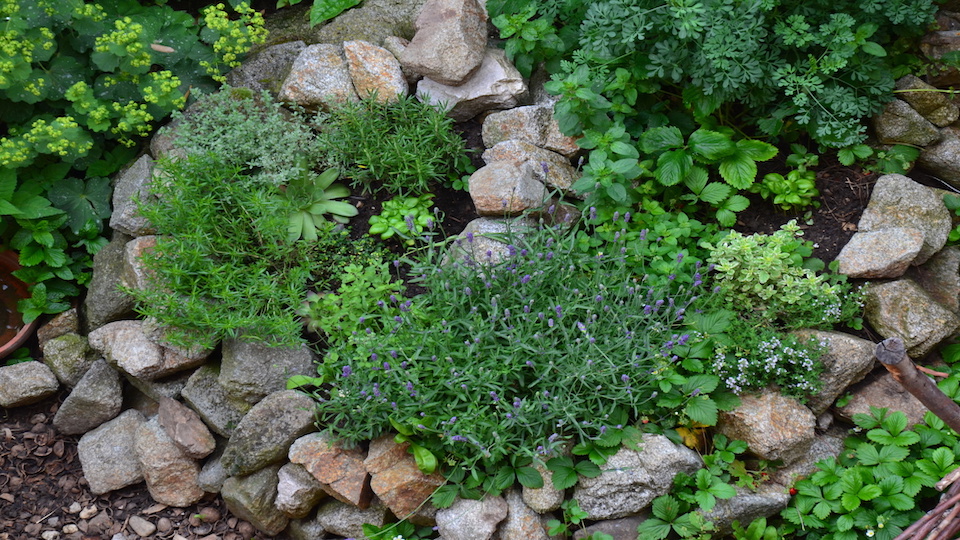Once you have the materials and a plan, you can build an herb spiral in an afternoon. This sturdy bed will last for years to come and is an excellent way to maximize space, save water, and keep your herbs close by. Follow these simple steps to create your own herb spiral today!
Remember, other than the basic structure, this garden bed is totally customizable. Check online for different materials and sizes to get an idea of what you want your herb spiral to look like, but ultimately, it should embody your gardening style and personality. Consider creating an herb spiral that complements your house if it is going to be near your entrance or backdoor.
What you’ll need:
- Cardboard: If you are placing your herb spiral on an untilled lawn, you will want cardboard (without color or tape) to kill the grass and prevent weeds. You can also use a weed mat or gravel.
- Drill for drainage holes: If your herb garden is going to go on a concrete patio, you may want to consider drilling drainage holes so that the water doesn’t leech out of the sides of the bed and stain your concrete. This shouldn’t be an issue unless it is a solid concrete slab.
- Long stake or stick: Attach three feet of string (or longer depending on your desired diameter) to this stake and tie a marking device on the other end, such as chack or a sharp stick. This will be used to measure out your bed and ensure you are placing your materials in a circle
- Organic matter for the bottom layer: Straw, mulch, garden soil or any other organic compound to build up height in the garden. You are not planting your herbs directly into this so it doesn’t need to be incredibly high quality. However, you will want materials that will feed your garden long-term. The amount you need depends on the size of your spiral.
- High-quality organic compost: It is important to give your herbs a good start so be sure the compost is rich and full of essential microorganisms.
- Mulch for the top layer: This can even be dried grass clippings and leaves. Just be sure it doesn’t have any weed seeds.
- Edging material: This could be bricks, cinderblocks, or stones.
- Plants: Most herbs do best when started from transplants rather than directly sown into the garden from seed.
Step 1: Choose a spot
You herb spiral will most likely be a permanent fixture in your garden so choose the location carefully. You will want to choose somewhere close to your kitchen that can be easily accessed out a backdoor. Make sure that the area receives at least 5 hours of full sun each day and position the bottom of the spiral towards the south. Having each side of your spiral representing a point on the compass will make it easier to plant herbs according to sun requirements.
Step 2: Mark your perimeter
Have someone stand (or stick the stake into the ground) where you want the center of your spiral to be and hold the stick. Stretch out the string and walk in a circle with the other end, marking the ground using the stick, stakes, or chalk to determine your perimeter. The herb spiral can be any size you want, but it usually ranges in size from 3-6 feet from the center.
Step 3: Prepare the ground
If you are building your herb spiral in the grass, you will want to cover the entire circle with an overlapping layer of unmarked cardboard. Wet the cardboard thoroughly to aid in decomposition and prevent it from blowing away. This step is essential and will prevent unwanted weeds and grass from growing into your bed. Plus, the cardboard will breakdown and provide carbon and food for your soil. You can also use gravel if you are constructing it on established soil.
Step 4: Build the wall
Start building the structure of your garden by laying out the material in a spiral shape. Leave approximately 1 ½’ to plant between each layer of rocks. For a more permanent look, you can use cement or mortar between the building material. You may find it helpful to add organic material as you go to help retain the shape and add support. Keep adding bricklayers and slowly increasing the height as you go. Remember, the bottom layer of the spiral should only be about 1-2 blocks off the ground. Just enough to contain the soil. The middle is usually around 3 feet high with a circular planting area in the center.
Step 5: Fill with organic material
Fill the bed with your organic material and top with a layer of compost. Incorporate whatever you have access to in order to fill your bed fully, but make sure that you use lots of organic material with teeming microorganisms to ensure soil fertility.
Step 6: Plant away
Have fun with the planting process and experiment with new and exciting ways to arrange the plants in your herb spiral.
-Taylor Ramsey




